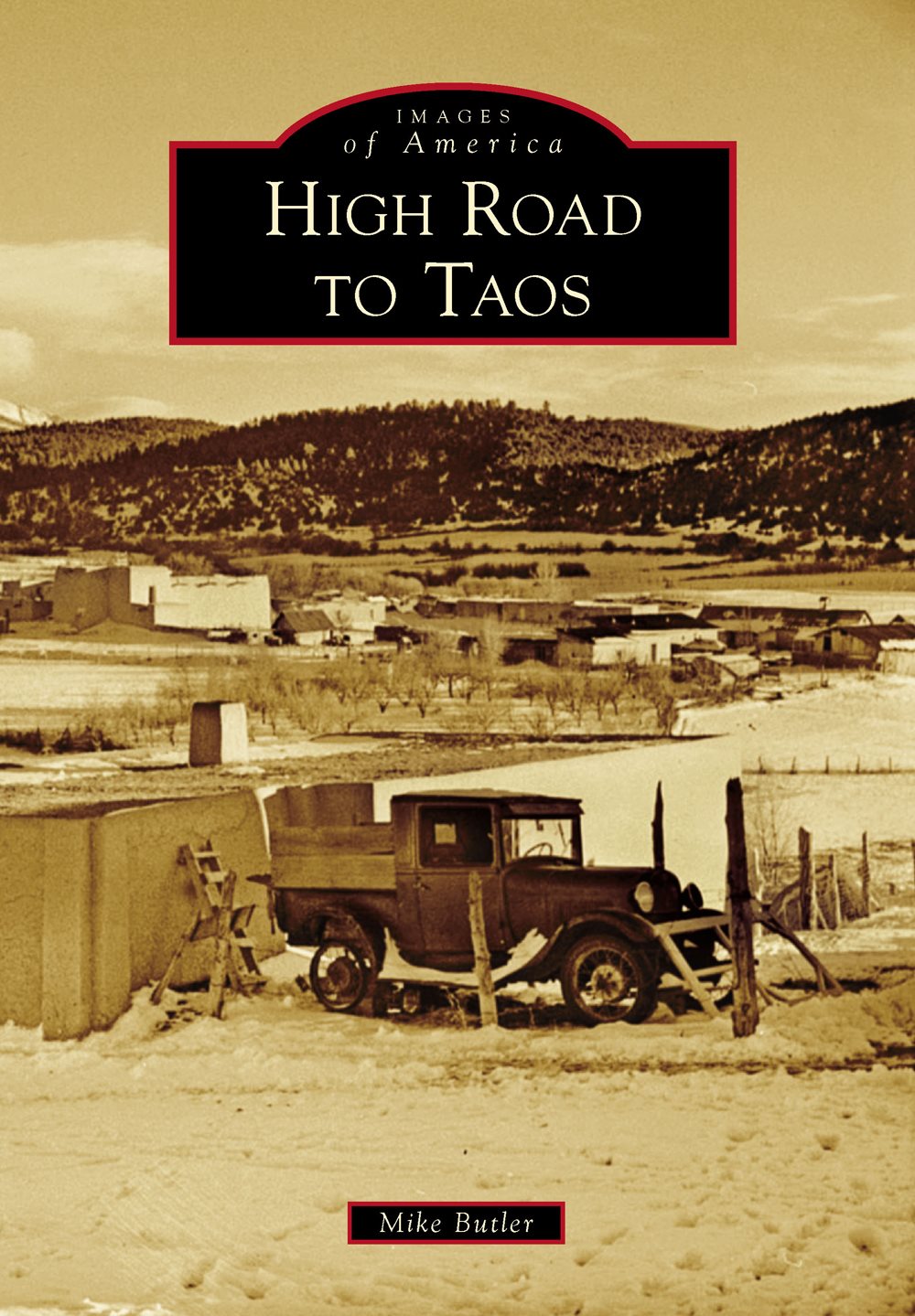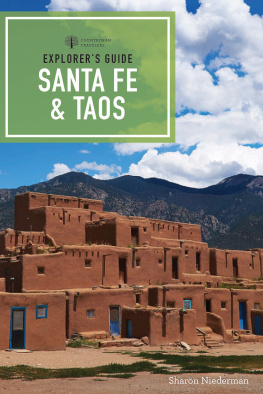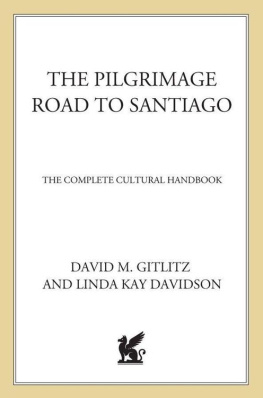
IMAGES
of America
HIGH ROAD
TO TAOS

FARM SECURITY ADMINISTRATION PHOTOGRAPHERS, 1937. This photograph taken by Beaumont Newhall shows, from left to right, Farm Security Administration (FSA) photographers John Vachon, Arthur Rothstein, and Russell Lee meeting with their boss, Roy E. Stryker. Photographs by Rothstein and Lee of High Road to Taos villages are included in this book. (Courtesy of Library of Congress, LC-DIG-ds-01154.)
ON THE COVER: LAS TRAMPAS, JANUARY, 1943. John Collier Jr., another FSA photographer, captured this view of Las Trampas looking northeast to the high mountains of the Sangre de Cristo Range. The tall building in the left center is the San Jose de Gracia Church, constructed in 1760. Snow blankets the ground, and the truck seems to need a new tire on the right rear. (Courtesy of Library of Congress, LC-USW3-017751-E.)
IMAGES
of America
HIGH ROAD
TO TAOS
Mike Butler

Copyright 2016 by Mike Butler
ISBN 978-1-4671-1605-3
Ebook ISBN 9781439656464
Published by Arcadia Publishing
Charleston, South Carolina
Library of Congress Control Number: 2015952318
For all general information, please contact Arcadia Publishing:
Telephone 843-853-2070
Fax 843-853-0044
E-mail
For customer service and orders:
Toll-Free 1-888-313-2665
Visit us on the Internet at www.arcadiapublishing.com
This book is dedicated to all the past, present, and future residents of the High Road communities and to those who travel along it.
CONTENTS
ACKNOWLEDGMENTS
Most of the photographs in this book appear courtesy of the Library of Congress (LC). Its collection of Farm Security Administration (FSA) photographs from the 1930s and 1940s exists thanks to a presidential executive order in 1944, which decreed that all film negatives and transparencies of the FSA (some 172,000 images) be preserved in the librarys collection. As these photographs were taken by US government employees, they are in the public domain and are available on the librarys website at www.loc.gov. Photographs courtesy of the Library of Congress are annotated in this book with the librarys image identification number, beginning with the initials LC. Other photographs courtesy of the librarys collection are from the Historic American Building Survey (HABS) and the Historic American Engineering Record (HAER), and those photographs are annotated with those initials. Photographs with no annotation were taken by the author.
Historic dates are somewhat problematic in New Mexico. Unless there are specific written historic records (e.g., Mexican independence in 1821 or New Mexico statehood in 1912), most dates in the text should be regarded as approximate, particularly settlement dates and church construction dates.
INTRODUCTION
Taos, New Mexicothe very name conjures images of native pueblos, adobe churches, towering mountain peaks, deep river canyons, and quaint art studios and galleries. And it is all here on the historic High Road to Taos Scenic Bywayapproximately 52 miles of history, culture, and scenery that is unmatched in the United States. The byway begins 16 miles north of Santa Fe at the junction of US Highway 84/285 and New Mexico Highway 503. From there, it heads north to its endpoint at Ranchos de Taos, affording the traveler with a trip back through time to the 1600s when Spanish settlers arrived in New Mexico. Indian pueblos along the route date back to the 1300s. Surviving adobe Catholic churches date from the 1760s. Small Hispanic mountain villages cling to the sides of the road, often exhibiting a lifestyle little changed since the 1800s. The High Road to Taos was listed in the New Mexico Register of Cultural Properties in 1975 in recognition of the rich cultural heritage of the places along the road.
New Mexico history is quite complex, and only a brief overview can be given here to help the traveler begin to understand the sights along the High Road. It all began when Spanish explorer Hernando Cortez landed with his fleet of 10 ships from Cuba on the mainland of Mexico, which he promptly named New Spain in 1519. The viceroyalty of New Spain was established by the Spanish crown in 1535; however, the name Mexico, which came from Mexica, the Aztecs name for themselves, was already being applied to the territory. Exploration of the territory of Mexico soon commenced, and explorers crossing north of the Rio Grande eventually referred to that area as Nuevo (New) Mexico. In 1539, in what is today the northwestern part of the state of New Mexico, those explorers stumbled upon the pueblo of Zui. They were searching for the fabled Seven Cities of Cbola, which were rumored to be fabulously wealthy with riches of gold and silver. A more organized expedition under Francisco Vasquez de Coronado returned to Zui on February 22, 1540, and a thorough exploration revealed six cities at Zui (not seven), and they were made of adobe (not gold). This could not be Cbola, so Coronado sent an advance exploration party under Hernando de Alvarado to continue exploration. It followed tributaries of the Rio Grande eastward and then northward, reaching Taos Pueblo in the summer of 1540.
Discouraged by not finding the cities of gold, Spanish exploration of New Mexico lagged for the next five decades. Finally, in early 1598, Don Juan de Oate led an expedition north along the Rio Grande. Oate had been granted the titles of governor of New Mexico and captain-general of New Mexico by the king of Spain. Oates mission was to pacify and Christianize the Indians and build Spanish homes along the Rio Grande. Oate took soldiers and their families, livestock, and supplies in order to accomplish his mission. After a journey of six months, they reached a pueblo that Oate named San Juan (known today by its native name, Ohkay Owingeh). Using sometimes brutal methods and forced labor of the natives, Oate established New Mexicos first capital city, named San Gabriel, on the west bank of the Rio Grande, opposite San Juan Pueblo on the east side. Almost immediately afterwards, Oate began visiting the far-flung outposts of his province, reaching Picurs Pueblo on July 13 and Taos Pueblo on July 14, 1598.
Throughout the 1600s, Spanish settlement along the Rio Grande continued. Some pueblos were subdued by force, and all pueblos suffered from forced labor and heavy taxation by the Spaniards, as well as curtailment of their pagan religious activities. Matters reached a turning point in 1680 when the pueblos united under the leadership of PoPay (also spelled Pope), a medicine man from San Juan Pueblo. After extensive secret planning with other pueblo leaders, PoPay led an armed revolt of the pueblo people against the Spanish in August 1680. The Puebloans were successful in their attacks, with as many as 1,000 Spaniards killed. In Taos, some 70 Spaniards were killed, including two Franciscan priests. Most Spanish mission churches were destroyed, along with all vestiges of Christianity. The attacks were so successful that all surviving Spaniards fled south along the Rio Grande to Mexico. For the next dozen years, the Spanish were gone from New Mexico. Then, in 1692, Don Diego de Vargas marched with troops north from Mexico and eventually completed the reconquest of New Mexico by the Spanish in 1696.
The first recorded date of a Taos trade fair was 1723; various Indian tribes met at Taos Pueblo to exchange goods. Spaniards eventually joined in the trade fair and, in the 1820s, were joined by French and American fur traders for a periodic rendezvous. The year 1821 saw Mexico gain independence from Spain, and while governed only loosely by Mexico City, the province of New Mexico removed regulations against trade with foreigners. This opened the way for the Santa Fe Trail, which brought thousands of Americans to Santa Fe, the capital of New Mexico, which had been established in 1610 when San Gabriel was abandoned as the capital city.
Next page








